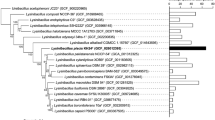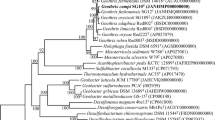Abstract
A polyphasic taxonomic study using morphological, biochemical, chemotaxonomic and molecular methods was performed on three strains of a Gram-stain positive, non-sporeforming, motile aerobic rod-shaped bacterium resistant to tylosin and tetracycline isolated from a swine-manure storage pit. On the basis of 16S rRNA gene sequence analyses, it was confirmed that these isolates are highly related to each other and form a hitherto unknown lineage within the Planococcaceae. In particular, pairwise analysis of the 16S rRNA gene sequence demonstrated that the novel organism is closely related to members of the genus Sporosarcina (92.8–94.5 %), Pyschrobacillus (93.5–93.9 %) and Paenisporosarcina (93.3–94.5 %). The predominant fatty acids were found to consist of iso-C15:0 and iso-C17:1 ω10c and the G+C mol% was determined to be 41.8. Based on biochemical, chemotaxonomic, and phylogenetic evidence, it is proposed that these novel strains be classified as a novel genus and species, Savagea faecisuis gen nov., sp. nov. The type strain is Con12T (=CCUG 63563T = NRRL B-59945T = NBRC 109956T).

Similar content being viewed by others
References
Ahmed I, Yokota A, Yamazoe A, Fujiwara T (2007) Proposal of Lysinibacillus boronitolerans gen. nov. sp. nov., and transfer of Bacillus fusiformis to Lysinibacillus fusiformis comb. nov. and Bacillus sphaericus to Lysinibacillus sphaericus comb. nov. Int J Syst Evol Microbiol 57:1117–1125
Albert RA, Archambault J, Lempa M, Hurst B, Richardson C, Gruenloh S, Duran M, Worliczek HL, Huber BE, Rosselló-Móra R, Schumann P, Busse H-J (2007) Proposal of Viridibacillus gen. nov. and reclassification of Bacillus arvi, Bacillus arenosi and Bacillus neidei as Viridibacillus arvi gen. nov., comb. nov., Viridibacillus arenosi comb. nov. and Viridibacillus neidei comb. nov. Int J Syst Evol Microbiol 57:2729–2737
Altenburger P, Kämpfer P, Makristathis A et al (1996) Classification of bacteria isolated from a medieval wall painting. J Biotechnol 47:39–52
Andrighetto C, De Dea P, Lombardi A et al (1998) Molecular identification and cluster analysis of homofermentative thermophilic lactobacilli isolated from dairy products. Res Microbiol 149:631–643
Arumugam M, Raes J, Pelletier E et al (2011) Enterotypes of the human gut microbiome. Nature 473:174–180
Brill JA, Wiegel J (1997) Differentiation between spore-forming and asporogenic bacteria using a PCR and Southern hybridization based method. J Microbiol Methods 31:29–36
Cotta MA, Whitehead TR, Zeltwanger RL (2003) Isolation, characterization and comparison of bacteria from swine faeces and manure storage pits. Environ Microbiol 5:737–745
Cotta MA, Whitehead TR, Collins MD, Lawson PA (2004) Atopostipes suicloacale gen. nov., sp. nov., isolated from an underground swine manure storage pit. Anaerobe 10:191–195. doi:10.1016/j.anaerobe.2004.04.001
Cotta MA, Whitehead TR, Falsen E et al (2012) Two novel species Enterococcus lemanii sp. nov. and Enterococcus eurekensis sp. nov., isolated from a swine-manure storage pit. Antonie Van Leeuwenhoek 103:89–98
Cashion P, Holder-Franklin MA, McCully J, Franklin M (1977) A rapid method for the base ratio determination of bacterial DNA. Analyt Biochem 81:461–466
Descheemaeker P, Lammens C, Pot B et al (1997) Evaluation of arbitrarily primed PCR analysis and pulsed-field gel electrophoresis of large genomic DNA fragments for identification of enterococci important in human medicine. Syst Evol Microbiol 47:555–561
Feilberg A, Liu D, Adamsen APS et al (2010) Odorant emissions from intensive pig production measured by online proton-transfer-reaction mass spectrometry. Environ Sci Technol 44:5894–5900
Gordon RE (1973) The genus Bacillus (Agriculture handbook; no. 427)
Grossman AD, Losick R (1988) Extracellular control of spore formation in Bacillus subtilis. Proc Natl Acad Sci USA 85:4369–4373
Groth I, Schumann P, Weiss N, Martin K, Rainey FA (1996) Agrococcus jenensis gen. nov., sp. nov., a new genus of actinomycetes with diaminobutyric acid in the cell wall. Int J of Syst Bacteriol 46:234–239
Hamada M, Yamamura H, Komukai C, Tamura T, Suzuki K-I, Hayakawa M (2012) Luteimicrobium album sp. nov., a novel actinobacterium isolated from a lichen collected in Japan, and emended description of the genus Luteimicrobium. J Antibiotics 65:427–431
Kimura M (1980) A simple method for estimating evolutionary rates of base substitutions through comparative studies of nucleotide sequences. J Mol Evol 16:111–120
Koransky JR, Allen SD, Dowell VR Jr (1978) Use of ethanol for selective isolation of sporeforming microorganisms. Appl Environ Microbiol 35:762–765
Krishnamurthi S, Bhattacharya A, Mayilraj S, NamesforLife LLC, Saha P, Schumann P, Chakrabarti T et al (2009a) Description of Paenisporosarcina quisquiliarum gen. nov., sp. nov., and reclassification of Sporosarcina macmurdoensis Reddy et al., 2003 as Paenisporosarcina macmurdoensis comb. nov. Int J Syst Evol Microbiol 59:1364–1370
Krishnamurthi S, Chakrabarti T, Stackebrandt E et al (2009b) Re-examination of the taxonomic position of Bacillus silvestris Rheims et al., 1999 and proposal to transfer it to Solibacillus gen. nov. as Solibacillus silvestris comb. nov. Int J Syst Evol Microbiol 59:1054–1058
Krishnamurthi S, Ruckmani A, Pukall R, Chakrabarti T (2010) Psychrobacillus gen. nov. and proposal for reclassification of Bacillus insolitus Larkin & Stokes, 1967, B. psychrotolerans Abd-El Rahman et al., 2002 and B. psychrodurans Abd-El Rahman et al., 2002 as Psychrobacillus insolitus comb. nov., Psychrobacillus psychrotolerans comb. nov. and Psychrobacillus psychrodurans comb. nov. Syst Appl Microbiol 33:367–373
Leser TD, Amenuvor JZ, Jensen TK et al (2002) Culture-independent analysis of gut bacteria: the pig gastrointestinal tract microbiota revisited. Appl Environ Microbiol 68:673–690
Ludwig W, Schleifer K-H, Whitman B (2009) Revised road map to the phylum Firmicutes. In: de Vos P, Garrity GM, Jones D et al (eds) Bergeys manual of systematic bacteriology. Springer, New York, pp 1–13
Miller LT (1982) Single derivatization method for routine analysis of bacterial whole-cell fatty acid methyl esters, including hydroxy acids. J Clin Microbiol 16:584–586
Miller DN, Varel VH (2001) In vitro study of the biochemical origin and production limits of odorous compounds in cattle feedlots. J Animal Scien 79:2949–2956
Mitani T, Heinze JE, Freese E (1977) Induction of sporulation in Bacillus subtilis by decoyinine or hadacidin. Biochem Biophys Res Comm 77:1118–1125
Myers EW, Miller W (1988) Optimal alignments in linear space. Comput Appl Biosci 4:11–17
Reddy GSN, Manasa BP, Singh SK, Shivaji S (2013) Paenisporosarcina indica sp. nov., a psychrophilic bacterium from a glacier, and reclassification of Sporosarcina antarctica Yu et al., 2008 as Paenisporosarcina antarctica comb. nov. and emended description of the genus Paenisporosarcina. Int J Syst Bacteriol 63:2927–2933
Ruan Z, Wang Y, Song J, Jiang S, Wang H, Li Y, Zhao B, Jiang R, Zhao B (2014) Kurthia huakuii sp. nov., isolated from biogas slurry, and emended description of the genus Kurthia. Int J Syst Evol Microbiol 64:518–521
Saitou N, Nei M (1987) The neighbor-joining method: a new method for reconstructing phylogenetic trees. Mol Biol Evol 4:406–425
Sasser M (1990) Identification of bacteria by gas chromatography of cellular fatty acids: Technical Note #101
Stackebrandt E, Ebers J (2006) Taxonomic parameters revisited: tarnished gold standards. Microbiol Today 33:152–155
Stackebrandt E, Goebel BM (1994) Taxonomic Note: A Place for DNA-DNA reassociation and 16S rRNA sequence analysis in the present species definition in bacteriology. Int J Syst Bacteriol 44:846–849
Stolz A, Busse H-J, Kämpfer P (2007) Pseudomonas knackmussii sp. nov. Int J Syst Evol Microbiol 57:572–576
Tamura K, Dudley J, Nei M, Kumar S (2007) MEGA4: molecular evolutionary genetics analysis (MEGA) software version 4.0. Mol Biol Evol 24:1596–1599
Tindall BJ (1990a) A comparative study of the lipid composition of halobacterium saccharovorum from various sources. Syst Appl Microbiol 13:128–130
Tindall BJ (1990b) Lipid composition of Halobacterium lacusprofundi. FEMS Microbiol Lett 66:199–202
Tindall BJ, Sikorski J, Smibert RA, Krieg NR (2007) Phenotypic characterization and the principles of comparative systematics. In: Reddy CA, Beveridge TJ, Marzluf GA et al (eds) Methods for general and molecular microbiology, 3rd edn. ASM Press, Washington, DC, pp 330–393
Vermette CJ, Russell AH, Desai AR, Hill JE (2010) Resolution of phenotypically distinct strains of Enterococcus ssp. in a complex microbial community using cpn60 universal target Sequencing. Microb Ecol 59:14–24
Villedieu A, Diaz-Torres ML, Hunt N, McNab R, Spratt DA, Wilson M, Mullany P (2003) Prevalence of tetracycline resistance genes in oral bacteria. Antimicrob Agents Chemother 47:878–882
Wayne LG, Brenner DJ, Colwell RR et al (1987) Report of the Ad Hoc Committee on Reconciliation of Approaches to Bacterial Systematics. Int J Syst Bacteriol 37:463–464
Whitehead TR, Cotta MA (2001) Characterisation and comparison of microbial populations in swine faeces and manure storage pits by 16S rDNA gene sequence analyses. Anaerobe 7:181–187
Whitehead TR, Cotta MA (2004) Isolation and identification of hyper-ammonia producing bacteria from swine manure storage pits. Curr Microbiol 48:1–7
Whitehead TR, Cotta MA (2013) Stored swine manure and swine faeces as reservoirs of antibiotic resistance genes. Lett Appl Microbiol 56:264–267
Whitehead TR, Cotta MA, Collins MD, Lawson PA (2004) Hespellia stercorisuis gen. nov., sp. nov. and Hespellia porcina sp. nov., isolated from swine manure storage pits. Int J Syst Evol Microbiol 54:241–245
Whitehead TR, Cotta MA, Collins MD et al (2005) Bacteroides coprosuis sp. nov., isolated from swine-manure storage pits. Int J Syst Evol Microbiol 55:2515–2518
Whittle G, Whitehead TR, Hamburger N et al (2003) Identification of a new ribosomal protection type of tetracycline resistance gene, tet(36), from swine manure pits. Appl Environ Microbiol 69:4151–4158
Wolfgang WJ, Carpenter AN, Cole JA, Gronow S, Habura A, Jose S, Nazarian EJ, Kohlerschmidt DJ, Limberger R, Schoonmaker-Bopp D, Sproer C, Musser KA (2011) Neisseria wadsworthii sp. nov. and Neisseria shayeganii sp. nov., isolated from clincial specimens. Int J Syst Evol Microbiol 61:91–98
Wolfgang WJ, Coorevits A, Cole JA et al (2012) Sporosarcina newyorkensis sp. nov. from clinical specimens and raw cow’s milk. Int J Syst Bacteriol 62:322–329
Yarza P, Yilmaz P, Pruesse E et al (2014) Uniting the classification of cultured and uncultured bacteria and archaea using 16S rRNA gene sequences. Nat Rev Microbiol 12:635–645
Acknowledgments
The authors also wish to acknowledge the valuable technical assistance by Rhonda Zeltwanger. We also thank Ken-ichiro Suzuki at the Biological Resource Center, National Institute of Technology and Evaluation (NBRC) for facilitating the analysis of the peptidoglycan. Thanks are also given to Jürgen Busse, Institut für Mikrobiologie, Veterinärmedizinische Universität Wien, Austria, for the quinone analysis. Mention of trade names or commercial products in this publication is solely for the purpose of providing specific information and does not imply recommendation or endorsement by the U.S. Department of Agriculture. The U.S. Department of Agriculture (USDA) prohibits discrimination in all its programs and activities on the basis of race, color, national origin, age, disability, and where applicable, sex, marital status, familial status, parental status, religion, sexual orientation, genetic information, political beliefs, reprisal, or because all or part of an individual’s income is derived from any public assistance program. (Not all prohibited bases apply to all programs.) Persons with disabilities who require alternative means for communication of program information (Braille, large print, audiotape, etc.) should contact USDA’s TARGET Center at (202) 720-2600 (voice and TDD). To file a complaint of discrimination, write to USDA, Director, Office of Civil Rights, 1400 Independence Avenue, S.W., Washington, D.C. 20250-9410, or call (800) 795-3272 (voice) or (202) 720-6382 (TDD). USDA is an equal opportunity provider and employer.
Author information
Authors and Affiliations
Corresponding authors
Additional information
Terence R. Whitehead and Paul A. Lawson have equally contributed to the work.
Electronic supplementary material
Below is the link to the electronic supplementary material.
Rights and permissions
About this article
Cite this article
Whitehead, T.R., Johnson, C.N., Patel, N.B. et al. Savagea faecisuis gen. nov., sp. nov., a tylosin- and tetracycline-resistant bacterium isolated from a swine-manure storage pit. Antonie van Leeuwenhoek 108, 151–161 (2015). https://doi.org/10.1007/s10482-015-0473-8
Received:
Accepted:
Published:
Issue Date:
DOI: https://doi.org/10.1007/s10482-015-0473-8




